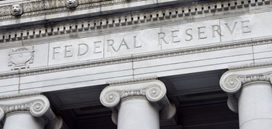Can Fed Introduce NIRP? Implications For Gold

 There might be some legal and practical problems associated with the introduction of NIRP. What does it mean for the Fed’s policy and the gold market?
There might be some legal and practical problems associated with the introduction of NIRP. What does it mean for the Fed’s policy and the gold market?
Legal Problems
As we pointed out on Monday, negative interest rates are a very hot topic in monetary policy and financial markets right now. Many investors wonder whether the Fed will join the club of central banks that have introduced negative interest rates. Apart from whether the U.S. central bank really wants to see interest rates below zero, there are legal issues. At a recent Congressional hearing, Rep. Patrick McHenry asked Janet Yellen about the Fed’s legal authority to make rates negative. She replied:
“In the spirit of prudent planning we always try to look at what options we would have available to us, either if we need to tighten policy more rapidly than we expect, or the opposite, to loosen policy. So we would take a look at it. But the legal issues, I am not prepared to tell you it's been thoroughly examined at this point. I am not aware of anything that would prevent us from doing it but I am saying that we have not fully investigated the legal issues - that still needs to be done.”
Fed’s Staff Memo
Some analysts argue that the Fed has no legal or technical authority to introduce NIRP. They point out the Fed Staff Memo from August 5, 2010, but released January 29, 2016. We can read there:
“There are several potentially substantial legal and practical constraints to implementing a negative IOER rate regime, some of which would be binding at any IOER rate below zero, even a rate just slightly below zero. Most notably, it is not at all clear that the Federal Reserve Act permits negative IOER rates, and more staff analysis would be needed to establish the Federal Reserve’s authority in this area.”
Why is it not clear? The reason is that the Federal Reserve Act states that “balances maintained at a Federal Reserve Bank by or on behalf of a depository institution may receive earnings to be paid by the Federal Reserve bank at least once each calendar quarter, at a rate or rates not to exceed the general level of short-term interest rates.” Negative interest rates imply collecting a levy from deposits, rather than paying interest on them. However, the phrase “may receive earnings” sounds like privilege rather than a right. Moreover, the Fed has the legal authority to charge for services, therefore it could introduce NIRP in a legal form of a service fee. Some analysts also point out that the Fed could introduce NIRP through reverse repo rates rather than IOER rates, circumventing vague rules.
Practical Constraints
The memo also mentions a few practical constraints. First, it notes that “the Federal Reserve computer systems used to calculate and manage interest on reserves do not currently allow for the possibility of a negative IOER rate”. It should not be any problem, since these systems could be modified if needed. We have the 21th century.
Second, “if negative IOER rates were to pull Treasury bill yields into negative territory, the Treasury would encounter difficulties because it cannot accept negative rates at its auctions”. It would not be a problem either, as the Treasury auction systems could be modified as well, if needed. Some European sovereign bonds have negative yields without any serious legal or technical problems.
Third, memo notes that at sufficiently negative interest rates, commercial banks “might opt to shift a significant quantity of their reserve balances into currency” and “present Federal Reserve inventories of currency, at about $200 billion, would not be adequate to cover large-scale conversion of the nearly $1 trillion in reserve balances to banknotes”. Undoubtedly, the cash shortage is a problem, however, it could be solved by more intense printing or by banning cash.
Conclusions
To sum up, the Fed faces some legal and technical constraints to implementing NIRP. However, there are relatively easy to overcome. If there is political will, and in times of crisis there is always political will, all needed changes will be made. Do you remember all the doubts about the legality of ECB’s quantitative easing? In the end, it turned out to be perfectly legal. Another example: before the financial crisis of 2007-2008, the Fed could not pay interest on excess reserve balances. But legislators enacted the Emergency Economic Stabilization Act of 2008 – and voilà! Therefore, if the Fed really wants to introduce NIRP, it will do it. It is positive news for gold, which should be the biggest beneficiary of negative interest rates. Actually, the yellow metal is already the biggest winner of the current hype about the NIRP.


















